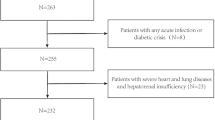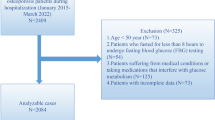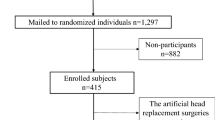Abstract
Post-BMT subjects have an increased bone fracture risk. Additionally, several factors were associated with osteopenia and osteoporosis in these individuals. We aimed to identify other factors associated with osteopenia and osteoporosis in allogeneic post-BMT subjects. We conducted a cross-sectional study with 47 allogeneic post- BMT subjects. Serum 25-hydroxyvitamin D (25(OH)D), parathyroid hormone, ferritin, vitamin B12, insulin, glucose, cholesterol and triglyceride levels were measured. Insulin resistance and secretion were estimated through the homeostatic model assessment for insulin resistance (HOMA-IR) and homeostatic model assessment for β-cell function (HOMA-B), respectively. A bone densitometry (BMD) was also obtained. The median time after BMT was 47.7 (12–115) months. Osteoporosis was identified in 17.0% of the subjects and osteopenia in 19.7%. The mean serum ferritin (P=0.002), insulin (P<0.0001), glucose (P=0.003) and triglyceride (P=0.018) levels were higher in individuals with osteopenia/osteoporosis. HOMA-IR (P<0.0001) and HOMA-B (P<0.0001) were increased in post-BMT subjects with osteopenia/osteoporosis. There was no other factor associated with the outcome. After adjustments ferritin, serum 25(OH)D and HOMA-IR remained independently associated with osteopenia/osteoporosis; however triglycerides no longer were. In conclusion, in the present study, low serum 25(OH)D levels, high serum ferritin levels and insulin resistance were associated with osteopenia/osteoporosis in post-BMT subjects.
This is a preview of subscription content, access via your institution
Access options
Subscribe to this journal
Receive 12 print issues and online access
$259.00 per year
only $21.58 per issue
Buy this article
- Purchase on Springer Link
- Instant access to full article PDF
Prices may be subject to local taxes which are calculated during checkout
Similar content being viewed by others
References
Buchs N, Helg C, Collao C, Chapuis B, Slosman D, Bonjour JP et al. Allogeneic bone marrow transplantation is associated with a preferential femoral neck bone loss. Osteoporos Int 2001; 12: 880–886.
Castaneda S, Carmona L, Carvajal I, Arranz R, Diaz A, Garcia-Vadillo A . Reduction of bone mass in women after bone marrow transplantation. Calcif Tissue Int 1997; 60: 343–347.
Kerschan-Schindl K, Mitterbauer M, Fureder W, Kudlacek S, Grampp S, Bieglmayer C et al. Bone metabolism in patients more than five years after bone marrow transplantation. Bone Marrow Transplant 2004; 34: 491–496.
Schimmer AD, Mah K, Bordeleau L, Cheung A, Ali V, Falconer M et al. Decreased bone mineral density is common after autologous blood or marrow transplantation. Bone Marrow Transplant 2001; 28: 387–391.
Gandhi MK, Lekamwasam S, Inman I, Kaptoge S, Sizer L, Love S et al. Significant and persistent loss of bone mineral density in the femoral neck after haematopoietic stem cell transplantation: long-term follow-up of a prospective study. Br J Haematol 2003; 121: 462–468.
Lee WY, Baek KH, Rhee EJ, Tae HJ, Oh KW, Kang MI et al. Impact of circulating bone-resorbing cytokines on the subsequent bone loss following bone marrow transplantation. Bone Marrow Transplant 2004; 34: 89–94.
Lee WY, Cho SW, Oh ES, Oh KW, Lee JM, Yoon KH et al. The effect of bone marrow transplantation on the osteoblastic differentiation of human bone marrow stromal cells. J Clin Endocrinol Metab 2002; 87: 329–335.
Lee WY, Kang MI, Oh ES, Oh KW, Han JH, Cha BY et al. The role of cytokines in the changes in bone turnover following bone marrow transplantation. Osteoporos Int 2002; 13: 62–68.
Baek KH, Oh KW, Lee WY, Tae HJ, Rhee EJ, Han JH et al. Changes in the serum sex steroids, IL-7 and RANKL-OPG system after bone marrow transplantation: influences on bone and mineral metabolism. Bone 2006; 39: 1352–1360.
Stein E, Ebeling P, Shane E . Post-transplantation osteoporosis. Endocrinol Metab Clin North Am 2007; 36: 937–963; viii.
Rakel A, Sheehy O, Rahme E, Lelorier J . Does diabetes increase the risk for fractures after solid organ transplantation? A nested case–control study. J Bone Miner Res 2007; 22: 1878–1884.
Fung EB, Harmatz PR, Milet M, Coates TD, Thompson AA, Ranalli M et al. Fracture prevalence and relationship to endocrinopathy in iron overloaded patients with sickle cell disease and thalassemia. Bone 2008; 43: 162–168.
Astner S, Anderson RR . Skin phototypes 2003. J Invest Dermatol 2004; 122: xxx–xxxi.
Instituto Brasileiro de Geografia e Estatistica 2000. http://www.ibge.gov.br/home/estatistica/populacao/censo2000/default.shtm, 2000.
Dodd KW, Guenther PM, Freedman LS, Subar AF, Kipnis V, Midthune D et al. Statistical methods for estimating usual intake of nutrients and foods: a review of the theory. J Am Diet Assoc 2006; 106: 1640–1650.
Thomas L, Huber AR . Renal function—estimation of glomerular filtration rate. Clin Chem Lab Med 2006; 44: 1295–1302.
Wallace TM, Levy JC, Matthews DR . Use and abuse of HOMA modeling. Diabetes Care 2004; 27: 1487–1495.
World Health Organization Assessment of fracture risk and its implication to screening for postmenopausal osteoporosis: techinical report series 843, WHO: Geneva, 1994.
Carmina E, Di Fede G, Napoli N, Renda G, Vitale G, Lo Pinto C et al. Hypogonadism and hormone replacement therapy on bone mass of adult women with thalassemia major. Calcif Tissue Int 2004; 74: 68–71.
MacKenzie EL, Iwasaki K, Tsuji Y . Intracellular iron transport and storage: from molecular mechanisms to health implications. Antioxid Redox Signal 2008; 10: 997–1030.
de Liefde II, van der Klift M, de Laet CE, van Daele PL, Hofman A, Pols HA . Bone mineral density and fracture risk in type-2 diabetes mellitus: the Rotterdam Study. Osteoporos Int 2005; 16: 1713–1720.
von Muhlen D, Safii S, Jassal SK, Svartberg J, Barrett-Connor E . Associations between the metabolic syndrome and bone health in older men and women: the Rancho Bernardo Study. Osteoporos Int 2007; 18: 1337–1344.
Williams JP, Blair HC, McDonald JM, McKenna MA, Jordan SE, Williford J et al. Regulation of osteoclastic bone resorption by glucose. Biochem Biophys Res Commun 1997; 235: 646–651.
Solomon DH, Avorn J, Canning CF, Wang PS . Lipid levels and bone mineral density. Am J Med 2005; 118: 1414.
Greenland S, Schwartzbaum JA, Finkle WD . Problems due to small samples and sparse data in conditional logistic regression analysis. Am J Epidemiol 2000; 151: 531–539.
Acknowledgements
The study was supported by Fundo de Incentivo a Pesquisa of the Hospital de Clínicas de Porto Alegre and by CAPES-Brazil, through the Post-graduation Programme in Medicine: Medical Sciences, Universidade Federal do Rio Grande do Sul, Porto Alegre, RS, Brazil.
Author information
Authors and Affiliations
Corresponding author
Rights and permissions
About this article
Cite this article
Faulhaber, G., Premaor, M., Moser Filho, H. et al. Low bone mineral density is associated with insulin resistance in bone marrow transplant subjects. Bone Marrow Transplant 43, 953–957 (2009). https://doi.org/10.1038/bmt.2009.70
Received:
Revised:
Accepted:
Published:
Issue Date:
DOI: https://doi.org/10.1038/bmt.2009.70
Keywords
This article is cited by
-
Increasing fasting glucose and fasting insulin associated with elevated bone mineral density—evidence from cross-sectional and MR studies
Osteoporosis International (2021)
-
To D or not to D: vitamin D in hematopoietic cell transplantation
Bone Marrow Transplantation (2020)
-
Factors influencing the late phase of recovery after bone mineral density loss in allogeneic stem cell transplantation survivors
Bone Marrow Transplantation (2016)
-
Association of lipid parameters and insulin resistance with bone health in South Korean adolescents
Osteoporosis International (2016)
-
Nonalcoholic fatty liver disease and decreased bone mineral density: is there a link?
Journal of Endocrinological Investigation (2015)



